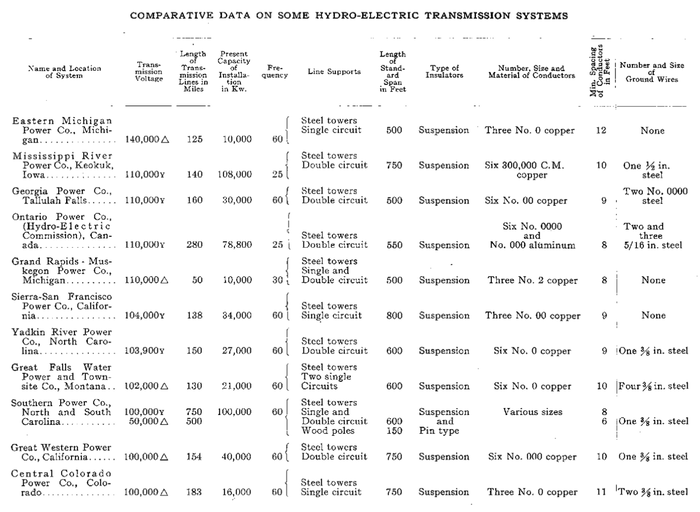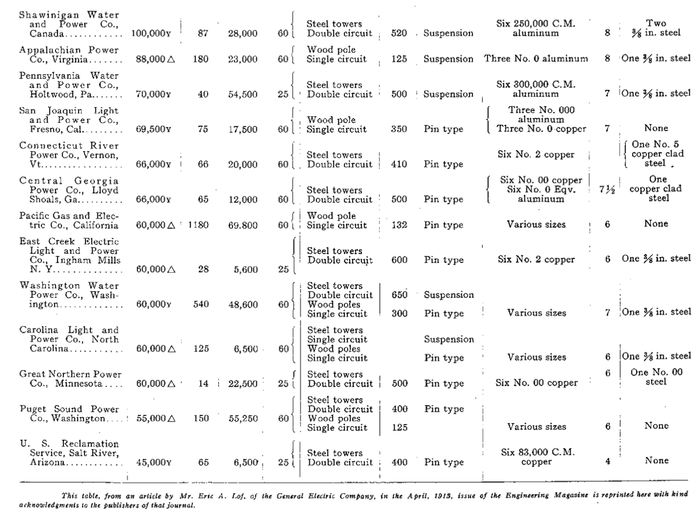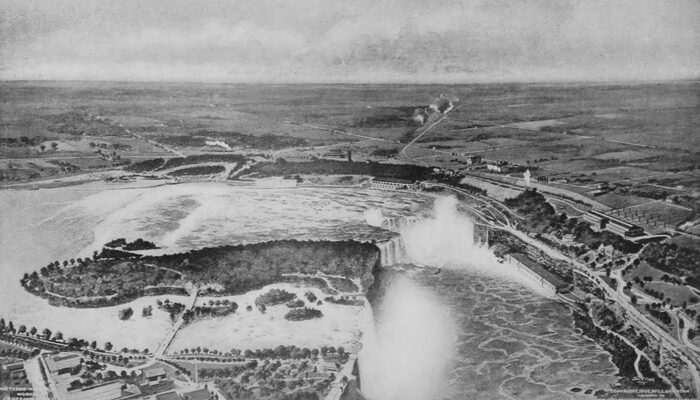[Trade Journal]
Publication: General Electric Review
Schenectady, NY, United States
vol. 16, no. 6, p. 348-354, col. 1-2
A REVIEW OF RECENT PROGRESS IN THE ENGINEERING OF HYDRO¬ELECTRIC POWER PLANTS AND TRANSMISSION SYSTEMS
BY DAVID B. RUSHMORE
ENGINEER, POWER AND MINING DEPARTMENT, GENERAL ELECTRIC COMPANY
The author briefly reviews recent progress under the headings of hydro-electric stations—syndicate control, waterwheel speeds; generators—temperatures, ventilation, insulation, braking; transformers—bushings, reactance, outdoor practice; low-tension switching versus high-tension; protection—busbar reactances, lightning arresters; line construction—ground wires, insulators, disposition of conductors; voltages for transmission and distribution. Nearly all of these matters are considered in greater detail in the articles which follow. The titles are for the most part descriptive, and we have therefore not keyed Mr. Rushmore's paragraphs with footnotes.—EDITOR.
The present problems in power transmission work are those resulting from an increase in the size of generator and transformer units, the increased capacities of power stations, the tendency toward complexity in transmission and distributing systems resulting from their growth, and from a combination of existing developments.
| |||
| Bird's-Eye View of the Niagara River at Niagara Falls, Showing the Water-Power Developments on the Canadian Side |
The rapid increase in transmission voltages is the dominating factor in forcing a new development in insulation and bushings, as well as in the transmission line itself; while a growing tendency toward more severe requirements with regard to continuity of service is at present focusing attention on the development of relays and automatic devices for isolating disturbances on high tension lines or apparatus connected thereto. New developments are constantly being made; and one of the most difficult problems at the present time is in meeting the conditions imposed by systems already in existence into which the new developments will fit. It will be the purpose of this article to review, in a broad way, recent progress in the development of apparatus for high-voltage power systems, which will enable the reader to form some idea of the problems which are still outstanding, and the directions in which further progress is likely to be made.
Hydro-Electric Stations
The recent development in the commercial field, whereby small electric systems have been grouped into large consolidations, has had a marked effect on both the financing and the engineering development of water powers. The condition under which such systems will operate can now be much more carefully pre-determined, and the hydraulic as well as the electrical apparatus best adapted to meet the requirements of service.
But few water powers in the country outside of those at Niagara Falls are suitable for development without auxiliary steam stations. Under present conditions it is often possible to know just what will be required of a hydro-electric plant, and to make plans to ensure that the maximum out¬put of the station can be realized. The possibility of forecasting future conditions at the time of development more accurately results in installing a larger generating capacity in proportion to the minimum stream flow than was heretofore desirable, and in thus being able to utilize more of the stream flow under ordinary conditions. Waterwheels are now being built for both higher actual and higher specific speed, with very greatly increased efficiencies, and waterwheel governors now represent a highly developed mechanism giving almost entire satisfaction.
Perhaps one of the most serious problems from the hydraulic side lies in dealing with the variable head caused by the backing up of water in times of flood.
Generators
While naturally both 60 and 25-cycle generators are being installed as conditions determine, the increase in the size of the individual units has made it desirable to wind a large number of these for 11,000 and 13,000 volts. Generator temperatures are now being measured with exploring coils, with an indicating instrument on the switchboard, which serves as an excellent guide for the operator.
The slight corona effect noticeable on some coils at high altitudes is being taken care of by proper design of the insulation. Very satisfactory results are being obtained by grading the insulation of high-voltage generators in the same way as is done on cables, with respect to the specific inductive capacity.
Probably the greatest refinement in modern generator practice is in regard to ventilation, whereby the air in proper quantities is directed in its path of movement. Elaborate precautions are being taken in many cases to bring this air to the machine from the coolest part of the wheel-pit, and in some cases through proper filterers. Considerations of safety for apparatus have led to the development of generators with comparatively high inherent reactance, and with saturation curves more straight than formerly.
Most vertical machines are now equipped with a brake, the location and design of which have not yet been well standardized. By mounting the supporting bearing at the top of the shaft these units have been made comparatively short, and certain advantages have been gained in power house construction. Not a few of the later developments also have the exciter mounted on the top of the shaft above the bearing, these exciters in some cases being direct-connected to the generator fields without the interposition of generator field rheostats.
At the present moment a rapid development is taking place in vertical bearings, and the experience of the next few years will be valuable in determining the advantages of the different designs.
Transformers
As transformers have increased in size, factors which have been hitherto negligible have now become of much importance, and thorough and painstaking investigations have been made into the mechanical and electric stresses to which these windings are subjected.
The modern large-capacity high-voltage transformer is a triumph of engineering skill. It has never received the tribute which it deserves, doubtless because of minor defects which have drawn attention from the really wonderful development which has been attained in this apparatus. Something over ninety-five per cent of the large high-voltage transformers are never heard from, and perform their service continuously and without interruption. This is a truly wonderful record and redounds to the credit of the engineers who arc responsible for the work.
The transformer bushing has become a feature of major importance, and much time and money have been expended in its development. The limitations of porcelain manufacture have here been a serious handicap.
The internal reactances of transformers have been increased with their increased size. Great improvements have been made in the methods of insulating transformers, as well as in their mechanical construction, and, it is -really surprising that the present satisfactory results with this class of apparatus are being obtained.
There is a very strong tendency to place transformers, switches and lightning arresters out of doors, and it is difficult to say just how far this will go, Results under these conditions, up to the present, have been quite satisfactory. For use in oil-insulated outdoor apparatus an oil has appeared on the market which does not freeze except at extreme low temperatures.
A very careful investigation into the electrical phenomena which occur in, transformer windings under different conditions, has brought to light many points not hitherto known, and has allowed the designing engineers to take the proper pre-cautions to prevent break-downs from these causes.
Switching
Investigations which have been made in a number of places indicate the danger to transformer windings of switching under load on the high-voltage side. There has not as yet been opportunity to investigate this problem as thoroughly as is desirable; but in the meantime it is recommended that all high-tension switching be reduced to a minimum, especially where large amounts of power and high voltages are involved. Wherever possible, high-voltage transformers should be made units with the line and the switching done on the low-tension side. This, however, is not always practicable; and it is probable that future conditions of operation may necessitate combinations of high-tension switches and relays for the isolation of sections of high-tension line in trouble.
Protection
The particular problems peculiar to each development are such that it has been found impossible to standardize systems of connection, and the proper arrangement for each installation is always the subject of much study with regard to the particular conditions affecting it.
One of the features of modern installations is the use of busbar reactances, and an adjustment of relays to the thermal storage capacities of the transformers. A careful balancing of the various advantages and disadvantages of the different systems, and a consideration of the present state of development of protective apparatus, have resulted in general consensus of opinion regarding the desirability of the delta connection for the high-tension side of transformers on transmission systems.
The development of switches and lightning arresters has kept pace with the use of increased voltages and outputs, and both classes of apparatus are giving very general satisfaction. The complex nature of electrical disturbances will probably prevent them from being exactly understood for some time to come, and our experimental investigations regarding their nature have been supplemented by theoretical considerations in the development of devices to protect against them.
Numerous accessory devices in the way of opening the generator fields, opening and closing the main switches, arcing-ground suppressors of various types, and line reactances have been used in different installations. The object, of course, is to prevent interruptions to service or to limit them to the shortest possible duration.
Line Construction
It has been suggested that a wire having a high surface-resistance be employed in the transmission line near the station, and also the use of line wires of a diameter which would always be below the corona break-down point. Many of these suggestions are interesting from a theoretical point of view and possess desirable, though unknown, values. Ground wires are being very generally used, and thousands of dollars are being expended upon them. It ought to be possible to determine, with a considerable degree of precision, just what their protective value is, but up to date this has not been done. Lightning rods on the steel towers have been suggested, in order to remove as far from the insulators as possible the point of break-down at times of discharge.
With the suspension insulators, and especially with the higher voltages where the insulator string becomes quite long, serious problems have arisen in connection with the mechanical features of the line, especially in regions where high winds prevail and where snow and sleet are a disturbing factor. Various shields and protecting rings have been suggested for use with these suspension insulators. One of the greatest causes of trouble in such lines has been in connection with the clamp holding the line wires. Owing to the flexibility of movement the position which this clamp assumes relative to the line and insulators undergoes considerable variation, and in times of high wind it has been the source of many breaks in the line conductor. In some cases it has been found necessary to anchor the wire to a cross-arm directly beneath it by a second string of insulators,
In a country where snow and sleet are to be expected, the practice of suspending the line wires directly beneath each other is to be avoided. Some unfortunate experiences have occurred where sleet has fallen from an upper to a central span, causing it to sag excessively—sometimes to such an extent as to bring the wires into contact with one another.
Wherever single-circuit towers are used, the placing of the three conductors in a horizontal plane appears to offer certain advantages; but it may be taken as an axiom that under present conditions, continuous service cannot he supplied over a single-circuit power line. Experience has shown the desirability of elevating the ground wires above the towers at a greater height than is to be obtained by placing them on the top of the arm supporting the insulators.
Voltages for Transmission and Distribution
The fact that high-tension transmission work has largely developed into high-voltage distributing systems, and the condition resulting from syndicating large numbers of heretofore isolated lighting and power systems, have resulted in the necessity of standardizing certain voltages. Owing to certain advantages in the apparatus and transmission line, 33,000 volts has in many cases been settled on as the best for distribution to the actual consumers. The transmission voltage can be 66,000 volts, and in some cases plans are being made to change this later to 132,000.
One of the present problems is to take off small amounts of power from high-voltage lines, and the development of inexpensive apparatus for doing this in a satisfactory manner is now the subject of very careful study. The tying of a new system into an old development brings with it many difficulties, especially where a considerable part of the power is used at a frequency different from that at which it is transmitted.
While, fortunately for the engineer, there are many present problems in power transmission work, it is gratifying to say they are being successfully solved, and that a standard of reliability of service is today being attained which a few years ago would have been thought impossible. Through the grouping of small developments into large systems, the ability to finance them has been made much easier; and the class of engineering which they have been able to obtain has been consequently very much improved. With the rapid increase in the grouping of lighting and railway properties, with the tremendous future extension of electrical power to mining and industrial work, and with the large field of railway electrification still before us, it is safe to say that the future of electric power transmission will be one of great magnitude and accompanied by noteworthy engineering developments.
 |
 |

